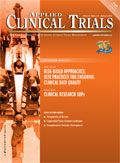Determining Suitable Overhead Rates to Use for Study Budgets
IMS Health
The viability of a research program can hinge upon a drug sponsor's success in negotiating a fair market price-including overhead rates-with investigators. Ultimately, when these contract costs don't align with the trial budget, sponsors end up squandering valuable resources.
Understanding site overhead expenses—those not directly related to conducting clinical studies—is a critical component of setting a fair market price for grants. Indeed, the overhead rate can be the single largest line item in a sponsor's study budget.
Yet, site overhead rates are commonly misunderstood, especially as they vary greatly by institution; they can range anywhere from 25% to 40% of the site's overall budget. Knowing where site overhead expenses fall within that range can be the key difference between developing a realistic budget for grants that sites will accept and developing a study budget that is grossly over or under funded.
Key overhead expenses include business development, insurance, information technology, supplies, and human resources. Also included are depreciation, profit (generally calculated at 8%), costs to attend industry conferences, occupancy (rent, power, and security), legal and accounting services, laundry and waste disposal, internal accounting, and interest expenses. Alternately, overhead can be considered an opportunity cost by representing the return on assets used to conduct the study (cash, property, furniture, equipment, supplies, etc.) that could otherwise be directed toward other profitable activities.
IMS Health has analyzed overhead rates by region, incorporating data from over 60 countries, 16 therapeutic areas, and more than 150,000 grants. Figure 1 shows the increase in overhead rates by region over the past three years. While the United States has generally had the highest overhead costs (24.9%) for all study phases, costs are rising most rapidly in emerging economies. As has been the case in other regions, we can expect these increases to level off once sites in these areas are more stable.

Overhead costs should be considered when selecting the best countries and sites for trials.
Overhead costs are significant enough that they should be one of many factors considered when selecting the best countries and sites for trials. Properly planning for sites' overhead costs requires an understanding of how expenses vary by geographic area and how those costs change over time. Budgets should be based on the most current information, given how rapidly things change in some regions.
—IMS Health (for more information contact clinicaltrials@us.imshealth.com)

Unifying Industry to Better Understand GCP Guidance
May 7th 2025In this episode of the Applied Clinical Trials Podcast, David Nickerson, head of clinical quality management at EMD Serono; and Arlene Lee, director of product management, data quality & risk management solutions at Medidata, discuss the newest ICH E6(R3) GCP guidelines as well as how TransCelerate and ACRO have partnered to help stakeholders better acclimate to these guidelines.
Gilead Shares Final Data from Phase III MYR301 Trial of Bulevirtide in Chronic Hepatitis Delta Virus
May 7th 2025Long-term results from the study show 90% of patients with chronic HDV who achieved undetectable HDV RNA at 96 weeks of treatment remained undetectable for nearly 2 years post-treatment.